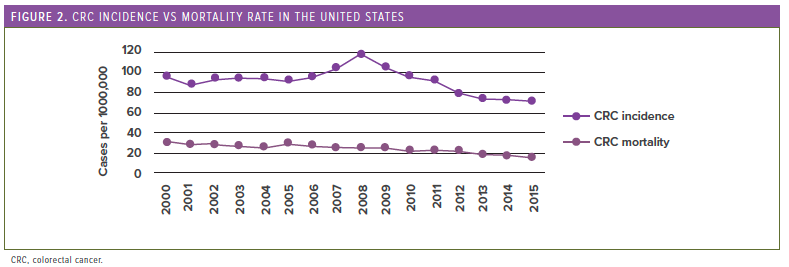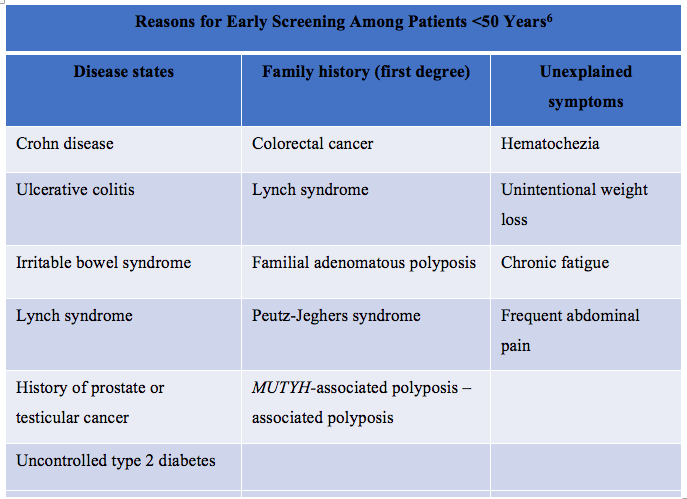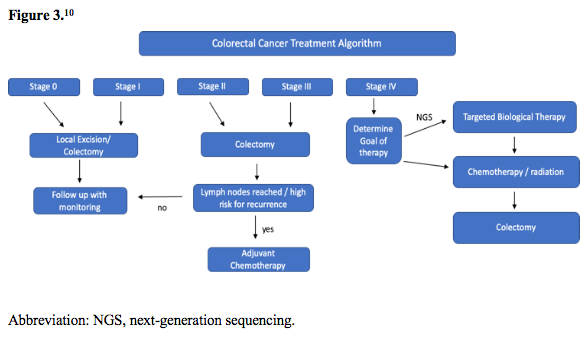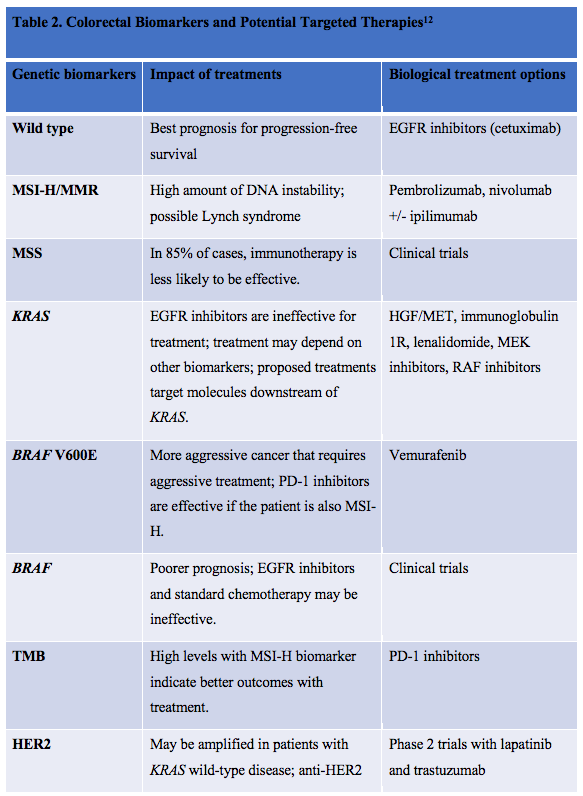Publication
Article
Pharmacy Practice in Focus: Health Systems
Early Screening Is Key in Colorectal Cancer
Author(s):
New treatments with biological agents and vaccines are creating a pathway for patients with metastatic CRC.
IN 2019, ABOUT 145,600 new cases of colorectal cancer (CRC) were diagnosed in the United States.1
CRC is the fourth-most-common malignancy in the United States, with an estimated 64.4% 5-year survival rate.1 The past 20 years have seen an overall decline in CRC-related deaths,1 and for patients with early detection or localized CRC, the survival rate is almost 90%. However, this percentage drastically plummets to 14% in patients with metastatic disease (Figure 1).1

CRC rates are about 30% higher in men, with higher mortality and incidence rates in African Americans and the lowest mortality incidence in Asian-Pacific Islanders, according to the National Cancer Institute.2
The highest percentage of deaths is among patients between ages 75 and 84. CRC occurs when polyps or tumors form in the lining of the large intestine, which can occur gradually over 10 to 15 years.2
Early Screening Reduces Mortality
Earlier screening is associated with a substantial decrease in CRC morbidity and mortality, thus controlling the costs of CRC treatments.3 This is the result of a significant increase in the number of individuals who undergo screenings. Data from 2000 to 2015 were associated with an increase in the number of screenings from 38.9% to 82.7%, respectively. This increase was associated with a 25.5% reduction in annual CRC incidences and a 52.4% reduction in cancer mortality rates (Figure 2). Most screening strategies have led to cost savings relative to increasing costs associated with chemotherapy for advanced CRC.4,5 Online Table 1 shows the reasons for screening for patients below age 50 who are at an increased risk of developing CRC.6


The 2 types of diagnostic screenings for CRC are stool testing and visual testing. The stool exams comprise the fecal immunochemical test, the guaiac-based fecal blood test, and the stool DNA, which, like the preceding 2 tests, screens for blood but also has the ability to detect DNA shed from tumors.7 Colonoscopy is the gold standard diagnostic screening for CRC. Colonoscopy allows for the direct visual examination of the entire colon and rectum, as well as the ability to excise polyps and suspicious lesions for biopsy.8 A new, noninvasive alternative is also available. The patient ingests a capsule containing on either end 2 miniature cameras, which capture images to allow direct visualization of the colon.9 Screenings are typically recommended for individuals at age 50 and repeated every 10 years. A cross-sectional analysis of CRC screenings across the United States has indicated a higher incidence in invasive procedures in patients aged 50 to 54 years compared with those aged 45 to 49 years. The evidence from this analysis suggests an overall underestimation of CRC and that early screening at age 45 may provide a cost-effective benefit for some individuals who later present with more extensive CRC when screened at age 50.10
Treatment
Treatment of CRC is based on the progression of cancer, with curative intent in early stages of diagnosis.11 Figure 3 provides a general algorithm for recommended treatment.10 Patients with localized CRC undergo surgery to remove the cancerous polyps or a partial colectomy to remove the cancer of the large intestine completely. CRC of stage II and beyond may require adjuvant chemotherapy because of the higher chance of recurrence or the extensiveness of metastasis. Common chemotherapy regimens include a combination of different agents, such as capecitabine with oxaliplatin, as well as fluorouracil, leucovorin, and oxaliplatin. Radiation therapy is considered for stage III and beyond to help relieve pain or for patients for whom surgery may not be an option.10

For patients with recurrence despite chemotherapy, immunotherapy may be an option if their cancer cell tests are positive for genetic changes. Options include a class of medications referred to PD-1 inhibitors, such as nivolumab and pembrolizumab, as well as CTLA-4 inhibitors, such as ipilimumab. Clinical trials and treatments using targeted therapy are still emerging (Table 2).12


Emerging Treatments
Results from a 2019 research article showed promise of a clinical trial involving a vaccine targeting guanylyl cyclase C, a receptor that has been linked to CRC recurrence. Current testing in phase 1 demonstrated no major adverse events from the vaccine in 10 patients with stage I and II CRC diagnoses. Animal testing in mice has shown promise, but further phase 2 and 3 trials are needed to validate CRC remission.13 Also, clinical trials and emerging therapies are beginning to focus on the use of next-generation sequencing to create effective individualized treatments of immunotherapy with or without chemotherapy.
Conclusion
Early diagnosis of CRC has shown optimal prognosis for survival, yet many barriers to screening still exist. Clinicians should provide risk stratifications in patients to determine who would benefit from early screenings before age 50. Although data indicate that early screening may be the key to reduce mortality rates of CRC, new treatments with biological agents and vaccines are creating a pathway to treat patients with metastatic CRC.
Jerry A. Barbee Jr, PharmD, BCPS, CPh, and Glenn Schulman, PharmD, MS, BCPS, BCACP, BCGP, BCIDP, are clinical pharmacists in Pensacola, Florida.Hayato DeLellis and Chelsea Phillips are PharmD candidates at the University of South Florida’s Taneja College of Pharmacy in Tampa.
REFERENCES
- SEER cancer statistics review (CSR) 1975-2016. National Cancer Institute. Updated April 9, 2019. Accessed April 9, 2020. https://seer.cancer.gov/csr/1975_2016
- Rectal cancer: what you need to know. Regional Cancer Care Associates. Accessed March 4, 2020. https://www.regionalcancercare.org/cancer-types/rectal-cancer
- Levin TR, Corley DA, Jensen CD, et al. Effects of organized colorectal cancer screening on cancer incidence and mortality in a large community-based population. Gastroenterology. 2018;155(5):1383-1391.e5. doi:10.1053/j.gastro.2018.07.017
- Simon K. Colorectal cancer development and advances in screening. Clin Interv Aging. 2016;11:967-976. doi:10.2147/CIA.S109285
- Imperiale TF, Kahi CJ. Cost-effectiveness of future biomarkers for colorectal cancer screening: quantified futility or call for innovation? Clin Gastroenterol Hepatol. 2018;16(4):483-485. doi:10.1016/j.cgh.2017.12.025
- What are the risk factors for colorectal cancer? CDC. Updated February 10, 2020. Accessed March 6, 2020. https://www.cdc.gov/cancer/colorectal/basic_info/risk_factors.htm
- Colorectal cancer screening tests. CDC. Updated February 10, 2020. Accessed March 9, 2020. https://www.cdc.gov/cancer/colorectal/basic_info/screening/tests.htm
- Issa IA, Noureddine M. Colorectal cancer screening: an updated review of the available options. World J Gastroenterol. 2017;23(28):5086-5096. doi:10.3748/wjg.v23.i28.5086
- Loyola University Health System. New alternative to colonoscopy is as easy as swallowing a pill. ScienceDaily. March 15, 2017. Accessed March 8, 2020. https://www.sciencedaily.com/releases/2017/03/170315144501.htm
- Abualkhair WH, Zhou M, Ahnen D, Yu Q, Wu XC, Karlitz JJ. Trends in incidence of early-onset colorectal cancer in the United States among those approaching screening age. JAMA Netw Open. 2020;3(1):e1920407. doi:10.1001/jamanetworkopen.2019.20407
- NCCN. Clinical Practice Guidelines in Oncology. Colon cancer, version I.2018. Accessed March 4, 2019. https://www.nccn.org/professionals/physician_gls/pdf/colon.pdf
- Sepulveda AR, Hamilton SR, Allegra CJ, et al. Molecular biomarkers for the evaluation of colorectal cancer: guideline from the American Society for Clinical Pathology, College of American Pathologists, Association for Molecular Pathology, and American Society of Clinical Oncology. J Oncol Pract. 2017;13(5):333-337. doi:10.1200/JOP.2017.022152
- Snook AE, Baybutt TR, Xiang B, et al. Split tolerance permits safe Ad5-GUCY2C-PADRE vaccine-induced T-cell responses in colon cancer patients. J Immunother Cancer. 2019;7(1):104. doi:10.1186/s40425-019-0576-2






